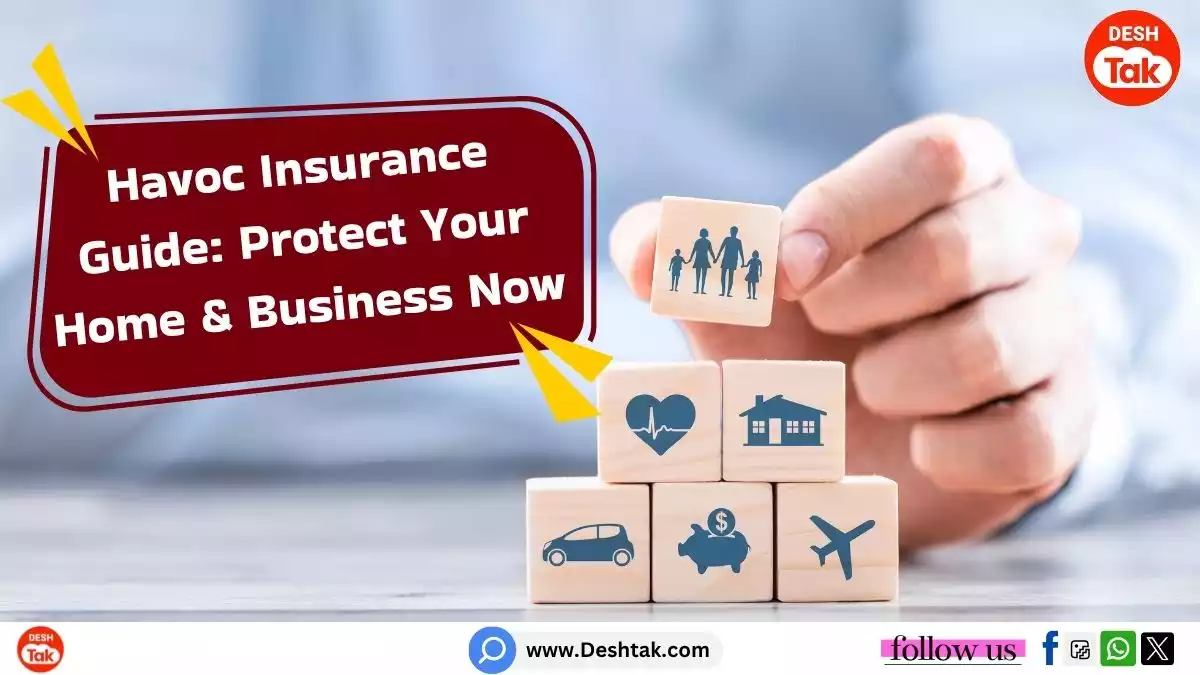Havoc Insurance Guide: Protect Your Home & Business Now
What is Havoc Insurance?
Every business owner knows insurance is essential. But do you know that today’s biggest ‘Havoc’ (devastation or catastrophe) doesn’t come from fire or flood, but from a single click? I’m not talking about the traditional policy that covers your office building. I’m talking about the invisible enemy with the potential to ruin your data, your reputation, and your entire operation—Cyber Risk.
Having worked in content and risk analysis for the past 20 years, I can tell you: the ‘Havoc Insurance’ you are searching for on Google isn’t a single product; it’s a necessity. The term is linked to solutions, like Havoc Shield, that address the “havoc” caused by cyber attacks on modern businesses. This solution doesn’t just help you buy insurance; it helps you become eligible to be insured.
In this guide, as an elite SEO strategist, I’ll show you how to tackle this ‘havoc’ of cyber security and turn Cyber Liability Insurance from a complicated burden into your business’s strongest armor.
The True Meaning of ‘Havoc’ and its Connection to Cyber Insurance
The direct meaning of ‘Havoc’ is destruction, ruin, or massive damage. In the insurance world, we often link it to natural disasters or major accidents. But in today’s digital age, the word has taken on a newer, more dangerous form.
What ‘Havoc’ Means in the Insurance World
Traditionally, when we talk about ‘Havoc’ cover, we refer to ‘Acts and Perils’—like earthquakes, riots, or sudden fires. The damage is visible, and the recovery is relatively simple because they are physical.
But here is my expert opinion: the financial and reputational ‘Havoc’ caused by a successful phishing attack today is no less severe than any natural disaster. It’s invisible, but the cost is often far greater.
Cyber Risk: The Biggest ‘Havoc’ for Modern Business
Small and Midsize Businesses (SMBs) have become easy targets for cyber criminals. They think only large corporations are targets, but the reality is the opposite. Over the last 3 years, the cost of cyber attacks on SMBs has increased by 60%. A key reason is that SMBs often fail to meet the minimum cyber security standards set by insurance companies.
Cyber risk is an invisible threat. For a simple analogy to understand it:
Simple Analogy: Cyber risk is like ‘termites’ in your house. You don’t see the termites, but they are eating away at your foundation (your customer data, your bank details). Traditional property insurance only helps after the roof collapses. Solutions like Havoc Shield secure the foundation before the termites get to it, ensuring your eligibility for insurance coverage.
Unresolved Dangers in Old/Traditional Insurance Policies
Your old ‘Business Interruption’ or ‘General Liability’ policy may not cover the damages from a cyber attack. The costs for legal fees, customer notification, or specialist data recovery after a cyber attack can all fall outside the scope of a traditional policy. This is why you need dedicated Cyber Liability Insurance, which requires you to meet specific cyber security and insurance terms.
Havoc Shield: The Solution for SMB Cyber Liability Insurance
When it comes to cyber insurance, complex forms, vague terms, and strict requirements feel like an exam for SMBs. Most applications are either rejected or become extremely expensive because the business doesn’t know what the underwriters (insurers) actually want.
This is where the concept of Havoc Shield comes in. Havoc Shield is a Cybersecurity Program-as-a-Service designed specifically for small businesses to easily obtain Cyber Liability Insurance and reduce their risk.
Havoc Shield Explained Simply
Think of it as a preparation machine that helps you pass the difficult insurance exam. Its core focus is not insurance, but Cyber Security Compliance. It acts as a bridge:
- It takes the complex requirements from insurance companies.
- It converts them into simple, actionable steps for SMBs.
- It proves to the insurer that you have taken those steps.
How it Helps SMBs Get Coverage
Our expert opinion is: Havoc Shield’s main power is not that it sells you insurance, but that it ‘prepares’ you for it. It’s a Compliance-as-a-Service model that eliminates the fear of insurance application rejection.
Havoc Shield primarily solves two problems:
- Complex Applications: Understanding and answering the technical questions asked on insurance forms.
- Inadequate Security: Identifying current security flaws that could jeopardize the policy.
It helps you implement the exact solutions that underwriters want to see to approve your policy. It’s a tool that gives you a chance to see your business through the underwriter’s eyes.
The Functionality and Uniqueness of the Shield Up Program
A key component of Havoc Shield is the Shield Up Program. Understanding its functionality is crucial because it directly impacts your premium cost and coverage acceptance rate.
The Most Complex Concept: Automated Control Verification
Simple Analogy: This is like an ‘online driving test’.
- The insurance company gives you 10 difficult questions (requirements), such as, ‘Do you have Multi-Factor Authentication (MFA)?’
- The Shield Up Program teaches you how to remediate those 10 things before you take the test and automatically verifies that everything has been implemented.
- It doesn’t just ensure you pass; it gives you an excellent scorecard, which can lower your premium and lead to immediate policy approval.
Through this partnership and program, the time taken for SMB cyber insurance applications has, on average, been reduced by up to 40%, which is a game-changer.
Cyber Insurance Requirements: Answering the 5 Difficult Questions with Havoc Insurance
Insurance companies today are no longer satisfied just by asking, “Do you have anti-virus?” The rising incidents of cyber attacks and ransomware have forced insurers to be stricter. They now want to see that you have implemented Cyber Security Controls in a meaningful way.
Insurance policies are no longer just indemnification; they are an enforceable contract. If you do not follow certain key security requirements, your policy can be denied at the time of a claim.
Essential Security Controls (MFA, EDR, Backup)
As an expert, I can tell you that insurance underwriters now focus almost entirely on these three ‘Minimum Requirements’. Programs like Havoc Shield help you fix these:
- MFA (Multi-Factor Authentication): This is the most crucial. Insurers now require your remote access (like VPN) and, critically, email accounts (the entry point for 90% of attacks) to be secured with MFA.
Simple Analogy: Your MFA is like a Double Lock on your house. The password is the first key; the MFA code is the second. No thief can get in with just one key.
- EDR (Endpoint Detection and Response): Old anti-virus is no longer sufficient. EDR can detect and stop threats on your laptops, servers, and other devices in real-time.
Simple Analogy: EDR is an alert security guard who watches every suspicious person entering your home (system), not just standing at the door.
- Regular and Offline Backup: This is your last hope in case of Ransomware. Underwriters want to ensure your backup is taken regularly and, most importantly, is disconnected from the network (Offline or Air-Gapped).
Simple Analogy: Backup is the second key to your house, which still works if the original is stolen or lost. Offline backup ensures the thief (ransomware) cannot steal the second key either.
Steps to Simplify the Underwriting Process
By using a solution like Havoc Shield, you provide the insurance company with a Scorecard. This not only proves that you have implemented security controls but also eases the underwriter’s job through automated control verification.
The result? Faster approval, fewer follow-up questions, and better premium rates, because you are now considered a lower-risk business.
Cyber Insurance Regulations in the Indian Context
In India, regulatory bodies like IRDAI (Insurance Regulatory and Development Authority of India) are also directing insurers to develop clear standards for cyber risks. These tightening regulations confirm that cyber insurance is no longer an optional feature but a business imperative. The seriousness of your digital risk management directly impacts your legal and financial liabilities.
Havoc Shield for Insurance Brokers: The Secret Weapon to Boost Sales and Credibility
As an insurance broker or agent, your challenge is not just selling policies, but remaining a trusted advisor to your clients in a complex and rapidly changing market. Due to the complexity of cyber insurance, many brokers lose clients during the application process or face rejection.
Havoc Shield helps establish your role not just as a salesperson but as a ‘Cyber Solutions Partner’.
How to Reduce Application Time by Up to 40%
Cyber insurance applications are often long and technical, causing clients to get bored and abandon the process midway.
- Expertise Injection: As an expert, I advise that a broker should no longer sell just a policy; they must sell a ‘Cyber Solution’. Havoc Shield helps brokers become ‘Tier 1 Cyber Advisors’, selling a long-term relationship, not just a premium.
- Havoc Shield’s simplified online portal and Automated Verification technology streamline this process. When you give the client a clear checklist and the tool for ‘what to fix’, the time taken to complete the application is, on average, reduced by 40%.
Guidance on Improving the Client’s ‘Cyber Fitness’
The best way to lower insurance premiums and secure coverage is to reduce the client’s risk. But most brokers lack this technical capability.
The Most Complex Concept: Improving the Client’s ‘Cyber Fitness’
Simple Analogy: This is like a ‘Health Check-up’.
- You go to the doctor (broker). The doctor doesn’t just sell insurance (coverage) but tells you what vitamins (MFA, EDR) you need to take so you don’t fall ill (cyber attack) at all.
- Havoc Shield assesses your client’s digital health, identifies deficiencies, and provides a direct path to remediation.
- Highlight the fact that providing clients with a technical solution also lowers the risk of a claim, which ultimately reduces the broker’s reputation and E&O (Errors and Omissions) risk.
Branding Yourself as a Trusted Cyber Advisor
Competition in the cyber insurance field is constantly increasing. You can stay one step ahead of your rivals only by providing value instead of just selling a product.
By using Havoc Shield, you show your clients that you take their risk seriously and proactively provide solutions. You are not just selling insurance; you are helping ensure their Business Continuity. This enhances your credibility with clients and makes you stand out from the competition.
Your Business Action Plan: How to Choose the Right Cyber Insurance Policy
You’ve completed your cyber risk assessment and improved your cyber fitness using a tool like Havoc Shield. Now the real challenge is: choosing the best cyber insurance policy from the market. Many SMBs make a mistake here, as they only look at the premium cost, not the depth of coverage.
Types of Coverage: First-Party vs. Third-Party
Cyber insurance is divided into two broad categories. As an expert, emphasize that both coverages are absolutely essential for you:
- First-Party Coverage: This covers the damage directly sustained by your business.
- Costs Included: Data recovery, system restoration, legal and forensic specialist fees, Business Interruption (when your work stops due to an attack), and Ransomware payment (if necessary).
- Third-Party Liability Coverage: This comes into play when a cyber attack on you causes damage to your customers or other external entities.
- Costs Included: Customer notification costs, legal defense costs, Regulatory Fines, and settlement costs associated with privacy or data breach lawsuits.
Expert Advice: Most SMBs only focus on ‘First-Party Coverage’ (their own loss) and forget ‘Third-Party Liability’ (customer loss). As an expert, emphasize that the legal costs (Third-Party) in a customer data breach are always far greater than the business’s own loss (First-Party).
The Most Complex Concept: First-Party vs. Third-Party Coverage
Simple Analogy:
- First-Party Coverage is the loss of your belongings when your house is robbed.
- Third-Party Coverage is when your dog (your server) bites the neighbor (your client) and you have to fight a lawsuit. Both are necessary, and covering both is part of digital risk management.
Evaluating Policy Cost and Coverage Limit
When choosing a policy, focus on these three things:
- Coverage Limit: Ensure the limit is equal to your Maximum Probable Loss. A general rule is to have cyber coverage of at least 10% to 15% of your annual revenue.
- Deductible or ‘Access’: This is the amount you have to pay out of your pocket before the claim kicks in. A lower deductible means a higher premium. Choose according to your risk tolerance.
- Exclusions: Read carefully what the policy does not cover. If you have knowingly not implemented essential security controls (like MFA), your policy may deny the claim.
A Long-Term Mindset in Digital Risk Management
Havoc Insurance, in this context, is not just a policy; it’s a process. Cyber security is not a static target; it’s constantly changing.
- Regularly audit your security systems.
- Maintain compliance using solutions like Havoc Shield.
- Continuously train your employees about phishing and social engineering.
- Re-evaluate your insurance coverage every year.
Final Word and Expert Advice (Conclusion and CTA)
We’ve seen how the search for ‘Havoc Insurance’ is really a search for solutions to cover the modern ‘havoc’ of cyber risk. Havoc Shield has simplified this complex process for SMBs and their brokers.
You run a business, not a computer security firm. Therefore, understanding and simplifying the complicated relationship between security and insurance is vital.
My final message as an expert:
- Be Proactive, Not Reactive: Don’t wait for a cyber attack to happen. Implement cyber security controls upfront using tools like Havoc Shield.
- Document, Don’t Guess: Don’t just tell the insurance company you have MFA. Certify that you have implemented it. This documentation is what prevents your policy from being invalidated at the time of a claim.
Cyber Liability Insurance is the strongest foundation for your business today. Ensure your foundation rests not just on paper, but on real security controls.
Cyber Insurance in the Indian Context: Key Providers and Comparative Analysis
The Indian cyber insurance market is rapidly evolving, with new regulations introduced by IRDAI (Insurance Regulatory and Development Authority of India) making insurance more structured. However, policies are still not ‘one-size-fits-all’. As an SMB owner, you should focus on the following top providers and the coverage they offer:
Top Indian Cyber Insurers for SMBs
While many options are available, here is a list of some large and reliable providers whose policies are suitable for the needs of SMBs:
| Insurance Provider | Policy Name (Example) | Key Focus | Specific Benefit for SMBs |
| HDFC ERGO | Cyber Sachet/Security | Individual and Business | Affordable Premium (individual plans start from ₹2/day), coverage for low-value assets. |
| ICICI Lombard | Cyber Insurance | Medium to Large Enterprises (SMEs) | Covers Data Breach and Business Interruption risks, access to expert support. |
| Bajaj Allianz | Cyber Safe Insurance | Individual, Professional, and Small Business | Good coverage on Network Security Liability and Cyber Extortion (Ransom). |
| SBI General | Cyber Defense/VaultEdge | Comprehensive Coverage | Worldwide coverage, emphasis on Ransomware, Reputation Cover, and Forensic Assistance Services. |
| TATA AIG | Cyber Insurance | Customizable | Good coverage for Customer Notification costs and Data Restoration. |
Expert-Level Questions When Choosing a Policy (Actionable Checklist)
Once you’ve implemented MFA, EDR, and Offline Backup through Havoc Shield, seek answers to these five critical questions when sitting with your insurance broker:
- Is the coverage limit adequate? Does it cover your Maximum Potential Financial Loss (e.g., 6 months of revenue + legal fees)?
- Does it cover employee negligence? Does it cover a breach caused by an employee’s mistake (like accidentally clicking a phishing link), or does it only include ‘intentional criminal acts’?
- What is covered under Ransomware? Does it cover not just the Ransom payment but also the costs of Forensic Investigation and System Restoration?
- Who are the Incident Response partners? Does the policy include a ‘Breach Coach’ or a panel law firm? Who will help you after an attack? (This is the most crucial).
- What are the deductible conditions? Does the deductible (the amount you have to pay) increase if you do not implement a specific security control like MFA or EDR?
The Final Step for Havoc Insurance Success
The essence of the entire process of obtaining cyber insurance is that buying a policy is not the end of the solution, but the beginning. You must adopt a long-term strategy:
- Adopt the Havoc Shield mindset: Assume you will be hacked. Adapt your security accordingly.
- Certify, Don’t Assume: Don’t just tell the insurance company you have MFA. Certify that you have implemented it.
- Read the Policy: Insurance policies are no longer just legal documents; they are your business’s digital security checklist.
Havoc Insurance is a shield that doesn’t just give you money; it allows you to continue operating in the digital age.
Best AI Tools 2025: Which AI Should Your Business Use?
Top 7 Clothes Remover AI Tools: A Complete Guide to Professional Photo Editing

India’s No. #10 Hindi news website – Deshtak.com
(देश और दुनिया की ताज़ा खबरें सबसे पहले पढ़ें Deshtak.com पर , आप हमें Facebook, Twitter, Instagram , LinkedIn और Youtube पर फ़ॉलो करे)













